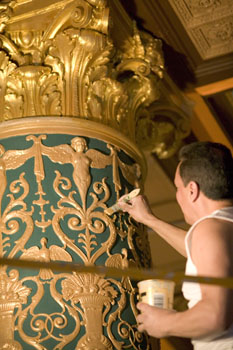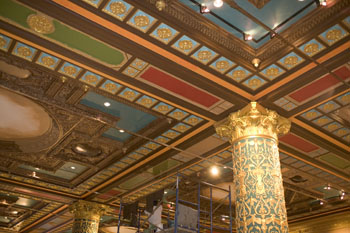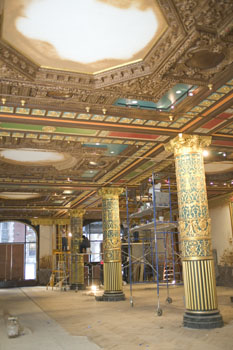Times Endorses Sam Taitt
45th District (East Flatbush and Flatlands): Two years ago the incumbent, Kendall Stewart, barely won re-election in a crowded field in this central Brooklyn district, where the population is mostly rooted in the Caribbean. Now Mr. Stewart, a podiatrist born in St. Vincent, faces a showdown with the second-place finisher, Sam Taitt.
This is the third race for Mr. Taitt, who began this campaign badly by successfully challenging the nomination petitions of three opponents. That would be reason to look for another candidate if the district was not so much in need of better representation. Mr. Taitt -- a native of Barbados, who teaches communication at Kingsborough College -- has both the experience and the drive to do a better job. Since the last campaign, he has worked hard on community education and economic development projects. He is leading an effort to form a community credit union, which could offer hope to residents overlooked by conventional banks.
Mr. Stewart has been a disappointment in the Council. He is chairman of the committee on immigration but has done little with the position. Sam Taitt offers a fresh approach, and he gets our endorsement.
An Elegant Old Hotel Gives New Lives to the Homeless
|
This series, in partnership with Open House New York, looks at the physical city since the birth of the preservation movement 40 years ago. |
For decades the Prince George Hotel, with its burnished wood, lavishly detailed ceilings and classical columns welcomed visitors to Edith Wharton's New York. But then the hotel declined, becoming one of New York's notorious welfare hotels in the 1980s, when it housed about 1,600 people. The city closed it in 1989.
Today, the hotel on East 28th Street has reopened, combining aspects of both of its previous incarnations. It once again provides housing to the formerly homeless, but the number of residents is far less, and they are able to take advantage of supportive services right in the building. At the same time, the Prince George has been restored to its former glory in what now has become one of Manhattan's official historic districts, called Madison Square North, with particular attention to its once-again elegant ballroom, a grand gathering place.
We at Common Ground, a non-profit dedicated to solving homelessness, are trying to preserve a piece of New York City's history and architecture and at the same time address a pressing social need.
A Model That Makes Sense
Common Ground currently houses approximately 1,700 individuals in a total of eight residences, including the Times Square Hotel and The Christopher in Chelsea. We are looking to develop 3,000 additional homes in the next ten years.
Supportive housing offers people a home while also providing them with an array of services in their apartment building. Working in partners, we have been able to offer the tenants on-site employment, counseling, health and social services. Research has shown that as individuals move out of homelessness, the supportive housing model fosters self-sufficiency and stability. In addition, supportive housing has also shown to be the most effective means to prevent homelessness and the most fiscally efficient -- the annual cost of providing an individual with supportive housing is far less than the average cost of providing a person with emergency medical or psychiatric care and shelter.
From Glamorous To Grim To Gorgeous
 |
The area around the Prince George, Madison Square, was Manhattan's social center in the 1850s, attracting prominent families who lived in brownstones on and near Fifth Avenue. The completion of the Lexington Avenue subway transformed the area from an affluent residential neighborhood to a commercial district. The Prince George, north of Madison Square Park, was a key part of that. One of the city's largest early 20th century hotels at 14 stories tall, it was constructed in two phases, with the main building going up in 1904 and a northern wing added in 1912. Howard Greenley, a prominent architect who served as the president of the Architectural League of New York, designed the building and decorated the interior.
The hotel is modeled in the Beaux Arts style and has many classical and neo-Renaissance flourishes. Its ground floor included the Lady's Tearoom, the English Tap Room, and the Hunt Room. A spacious lounge later became the Prince George Ballroom. Designed by Greenley, the ornate ballroom featured Renaissance-inspired murals and reproductions of famous paintings, along with intricate woodwork, marble mosaic floors, ceiling murals, and elaborate carvings.
For decades, the Prince George Hotel and its restaurants were favorite gathering places. Even in the 1950s, long past its heyday, the hotel continued to draw middle-class tourists. But as tourism in the city declined in the 1970s, the Prince George, along with many New York hotels, began to suffer. With the rise in homelessness in the 1980s, many private hotels in the area, including the Prince George, began to accept contracts from the city to house homeless families. During this period, the ballroom served as a dining hall, social service office and basketball court.
Since the Prince George did not offer adequate facilities, services or security to its residents, the hotel became dirty and dangerous, ridden with drug use and crime, damaging its residents and the surrounding community. Writer Jonathan Kozol called the Prince George at that time "one of the grimmest places I've ever been." After standing vacant for several years, the Prince George was purchased by Common Ground in 1996.
 |
Backed by federal, state and private funds, the renovation began two years later, the work of Beyer Blinder Belle, the architects who designed the renovation of Grand Central Station. Historic rehabilitation tax credits financed some of the renovation of the lobby. In 2001, after the hotel was largely renovated, the city designated the surrounding area a historic district. This would set restrictions on future changes, if any, to the building's exterior.
The hotel, in its current incarnation, welcomed its first tenants in October 1999. Today, the Prince George provides 416 units of permanent, affordable, supportive housing for low-income or formerly homeless adults, including people with HIV/AIDS or mental illness and the elderly. The residents pay 30 percent of the income in rent. About half the residents have incomes of less than $10,000 a year. Common Ground's social services partner, the Center for Urban Community Services, provides tenants with on-site access to social, medical and psychiatric services, along with benefits counseling and a wide range of community activities. The building also includes such facilities as a computer room, lounges and an art studio.
At the Prince George, the physical setting contributes to giving residents a sense of dignity. The ornate tearoom, as well as part of the lobby, has been elegantly restored. The Prince George also features a gorgeous rooftop deck with a community garden.
A Ballroom Restored, Creatively, Collaboratively
 |
In 2004, Common Ground launched an ambitious project to restore the 5,000 square-foot ballroom and adjacent former Hunt Room. The project presented an opportunity to offer needed training and jobs. Common Ground, working with four other non-profit groups, arranged for at-risk youth, high school students interested in restoration arts, architectural students, and individuals with HIV/AIDS to work on the renovation. Students at the Parsons School designed and built an entry foyer and gallery space in what had been the Hunt Room. Faced with an area that was beyond restoration, the students developed an airy, modern space that is now the World Monuments Fund Gallery, which serves as a special exhibition and events space.
Meanwhile, staff from the Alpha Workshops, which provides training and employment in the decorative arts for people with HIV/AIDS, restored the original plasterwork and paint in the Neo-Renaissance Ballroom, which had suffered significant water damage when the building lay vacant. They also provided hands-on training to a group of young people from the Brooklyn High School for the Arts, YouthBuild USA, and the Foyer program at The Christopher, the Common Ground facility that houses young adults who have been in the foster care system. The ballroom's elaborate Renaissance details — including heavy columns ornamented by cartouches, garlands, angels and acanthus leaves — have been restored through this unique partnership.
The ballroom, which can seat up to 299 guests, and the World Monuments Fund Gallery at the Prince George have opened as a special events and exhibition space available to the public. The income generated by renting out this space goes to support our efforts to house chronically homeless adults -- an innovative re-use of a beautiful old building.
Kelly Castagnaro is director of communications at Common Ground.
Â
Daily News Endorsement of Robert Morgenthaus
August 28, 2005 Sunday
Daily News Editorial
ROBERT MORGENTHAU FOR MANHATTAN DA
There are few public officials who merit being described as distinguished and fewer still who deserve the distinction for decades of service. Robert Morgenthau is one who does. Seeking reelection after 30 years as Manhattan district attorney, Morgenthau leads a prosecutor's office that is the national gold standard. His record on bringing criminals to justice, whether they be street thugs, corrupt politicians or thieving corporate chieftains, is superb. The borough's Democrats must serve the public good by voting to return Morgenthau to office in the Sept. 13 primary.
Years 26 through 30 have been remarkably productive for Morgenthau. His assistants brought far more accused felons to trial than did their peers in the other boroughs, had the highest trial conviction rate and sent by far the highest percentage to prison after guilty verdicts and pleas.
By themselves, those batting averages call for extending Morgenthau's tenure. But the statistics are all the more impressive when you consider his ambitious range of prosecutions. Thousands of murderers, robbers and rapists were packed off to prison while the DA's office also brought the high and mighty to justice. Morgenthau's newly minted convicted felons include former Tyco chief executive Dennis Kozlowski, former state Sen. Guy Velella, former Assemblywoman Gloria Davis and the leadership of the roofers' union, to name a few.
Along the way, Morgenthau also took on the role of Wall Street cop, prosecuting corrupt bankers, stockbrokers and money launderers and recouping $50 million for the state and city from JPMorgan Chase and Citigroup for their roles in the Enron fraud. And his office is deeply involved now in probing the UN oil-for-food scandal.
Morgenthau's opponent, Leslie Crocker Snyder, served for 20 years as a justice in Manhattan Supreme Court, earning a reputation for meting out tough sentences that provoked death threats from drug gangs. Before her judgeship, Snyder, 63, worked as a Manhattan assistant DA for nine years, during which she became the first woman in the history of the office to try homicides. Snyder, in other words, has a fine résumé. What she lacks is a rationale for dumping Morgenthau.
The central tenet of Snyder's campaign is that the DA's office has "grown stale and out of touch." Her accusation is a transparent reference to Morgenthau's age, 86, and is meant to suggest that everyone would be better off if the coot retired to pick apples. Some may agree. Among them we'd count contractor Phillip Minucci, who got 10 years after Morgenthau slammed him with innovative manslaughter charges stemming from the deaths of five $7-an-hour immigrant masonry workers.
Snyder's proposals for the DA's office range from a sensible focus on domestic violence to a wrongheaded retreat from Morgenthau's white-collar prosecutions. She says, for example, that she would have let other authorities pursue Tyco, forgetting that millions of small shareholders need a watchdog over corporate honesty. She also overlooks that Morgenthau's white-collar cases are a profit center for the city and state, recouping millions of dollars a year in fines, forfeitures and unpaid taxes.
Our occasional differences with Morgenthau - for example, he refused to apply the state's now-defunct death penalty law - pale in comparison to the sweep of his accomplishments. He has prosecuted without fear or favor, pursuing crime in the suites as well as in the streets, and he still has his fastball. The Daily News gives Robert Morgenthau its unqualified, wholehearted endorsement.
Â





